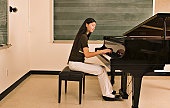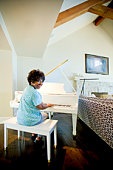
Home > Beginner Piano Lessons > Correct Way to Sit at the Piano
|
||||
Correct Way to Sit at the Piano
Many pianists simply sit down and start playing without a single thought to their form. A few weeks down the road when they feel wrist pain, they simply blow it off and keep playing. In this article, we will discuss the correct way to sit behind a piano so that you can alleviate as much stress as possible from your joints and limbs. This will help you avoid piano related aches and pains. Pain while playing is a red light. The pain is your body’s way of telling you that you are doing something wrong. Never play through pain. Instead, take the time to assess where the pain is coming from. If it is in your wrists, it can be coming from one of two places; your back (the signal travels through the nerves into your arms) or your wrist itself. Either way both can be corrected in the same fashion; posture. When sitting at a piano, your knees should always be beneath the keys. This prevents you from overreaching to get further keys. It also prevents you from leaning or arching your back to reach the piano itself. Your back should always be straight. Your spine should be erect, including your lower spine. Your lower back is the area most prone to slouching as it tends to be the weakest area of the back. The only way to strengthen it is by sitting straight up.
There is no purpose on sitting up straight if you crane your neck. Craning your neck is the equivalent to hunching over. It puts pressure in your spine in its weakest areas. You want to keep your entire spinal column in a strong position. Your muscles should be doing the work to support your spine. Make sure that your chin is level. This will help you to keep your neck straight. You want your elbows to be close to your body. The further away they are, the more effort your body needs to keep them out. You want every single movement to require as little effort as possible. Your wrists should point downwards (although that one is fairly obvious) and your body should stay relaxed. Your feet should be planted, when not using the pedals, directly under your butt. Your body should be a line. You want your body to be so straight that someone could hold up a yardstick next to you and have you match it. After you sit at the piano and achieve proper posture, don’t stop there. Keep an awareness of your posture while you play. It is easy to slip out and start leaning or slouching once you get comfortable. The easiest way to prevent this is by paying attention to your body.
=> http://pianoplayerworld.com/RocketPiano.html
| ||||
|
Although every attempt has been made to make information as accurate as possible, we are not responsible for any errors that may appear.
 In music, posture is everything. It can help you become a better player,
and it can disable your limbs. Posture is the single most important aspect of playing an instrument. It is
also the most often overlooked aspect.
In music, posture is everything. It can help you become a better player,
and it can disable your limbs. Posture is the single most important aspect of playing an instrument. It is
also the most often overlooked aspect.
 When sitting straight, your shoulders should be level. Your shoulder
blades just be brought back slightly, just enough so that your chest is brought forward. Your neck should be
erect as well.
When sitting straight, your shoulders should be level. Your shoulder
blades just be brought back slightly, just enough so that your chest is brought forward. Your neck should be
erect as well.



